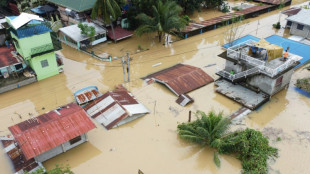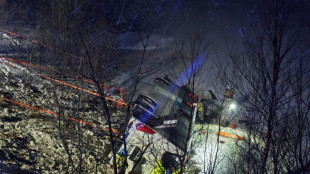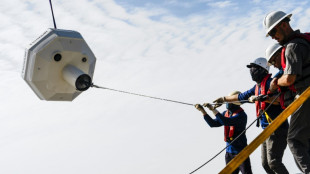
-
 Fresh strike hits Yemen's rebel-held capital
Fresh strike hits Yemen's rebel-held capital
-
Netflix with Beyonce make splash despite NFL ratings fall

-
 Bird flu mutated inside US patient, raising concern
Bird flu mutated inside US patient, raising concern
-
Slovakia says ready to host Russia-Ukraine peace talks

-
 Maresca challenges Chelsea to react to Fulham blow
Maresca challenges Chelsea to react to Fulham blow
-
Tech slump slays Santa rally, weak yen lifts Japan stocks higher

-
 Test records for Zimbabwe and Williams as Afghanistan toil
Test records for Zimbabwe and Williams as Afghanistan toil
-
LawConnect wins punishing Sydney-Hobart yacht race

-
 Barca's Yamal vows to 'come back better' after ankle injury
Barca's Yamal vows to 'come back better' after ankle injury
-
Olmo closer to Barcelona exit after registration request rejected

-
 Watching the sun rise over a new Damascus
Watching the sun rise over a new Damascus
-
Malaysia man flogged in mosque for crime of gender mixing

-
 Montenegro to extradite crypto entrepreneur Do Kwon to US
Montenegro to extradite crypto entrepreneur Do Kwon to US
-
Brazil views labor violations at BYD site as human 'trafficking'

-
 No extra pressure for Slot as Premier League leaders Liverpool pull clear
No extra pressure for Slot as Premier League leaders Liverpool pull clear
-
Tourists return to post-Olympic Paris for holiday magic

-
 'Football harder than Prime Minister' comment was joke, says Postecoglou
'Football harder than Prime Minister' comment was joke, says Postecoglou
-
Driver who killed 35 in China car ramming sentenced to death

-
 Bosch gives South Africa 90-run lead against Pakistan
Bosch gives South Africa 90-run lead against Pakistan
-
French skier Sarrazin 'conscious' after training crash

-
 NATO to boost military presence in Baltic after cables 'sabotage'
NATO to boost military presence in Baltic after cables 'sabotage'
-
Howe hopes Newcastle have 'moved on' in last two seasons

-
 German president dissolves parliament, sets Feb 23 election date
German president dissolves parliament, sets Feb 23 election date
-
Slot says 'too early' for Liverpool title talk

-
 Mayotte faces environment, biodiversity crisis after cyclone
Mayotte faces environment, biodiversity crisis after cyclone
-
Amorm says 'survival' aim for Man Utd after Wolves loss

-
 Desertions spark panic, and pardons, in Ukraine's army
Desertions spark panic, and pardons, in Ukraine's army
-
China sanctions US firms over Taiwan military support

-
 World number six Rybakina makes winning start at United Cup
World number six Rybakina makes winning start at United Cup
-
Israeli strikes hit Yemen airport as WHO chief prepares to leave

-
 Swiatek not expecting WADA appeal over doping scandal
Swiatek not expecting WADA appeal over doping scandal
-
'Dangerous new era': climate change spurs disaster in 2024

-
 Fritz motivated for Slam success after low-key off-season
Fritz motivated for Slam success after low-key off-season
-
Move over Mercedes: Chinese cars grab Mexican market share

-
 Zverev aiming to challenge Sinner for top ranking
Zverev aiming to challenge Sinner for top ranking
-
N. Korean soldier captured in Russia-Ukraine war: Seoul

-
 Inspired Tsitsipas looking to 'refresh, regroup' in Australia
Inspired Tsitsipas looking to 'refresh, regroup' in Australia
-
Seahawks edge Bears to boost NFL playoff hopes

-
 Thunder NBA win streak at nine as Shai ties career high with 45
Thunder NBA win streak at nine as Shai ties career high with 45
-
India announces state funeral for ex-PM Manmohan Singh

-
 Japan govt approves record budget for ageing population, defence
Japan govt approves record budget for ageing population, defence
-
Japanese shares gain on weaker yen after Christmas break

-
 South Korea's acting president faces impeachment vote
South Korea's acting president faces impeachment vote
-
Fleeing Myanmar, Rohingya refugees recall horror of war

-
 Smith century puts Australia in control of 4th Test against India
Smith century puts Australia in control of 4th Test against India
-
Israeli strikes hit Yemen as Netanyahu fires warning

-
 Peru ex-official denies running Congress prostitution ring
Peru ex-official denies running Congress prostitution ring
-
Australia's Smith reaches 34th Test century

-
 NHL Red Wings fire Lalonde and name McLellan as head coach
NHL Red Wings fire Lalonde and name McLellan as head coach
-
The Bilingual Book Company Launches New, Innovative Bilingual Audiobook App

| CMSD | -0.78% | 23.295 | $ | |
| CMSC | -0.64% | 23.51 | $ | |
| BCC | -1.81% | 120.75 | $ | |
| SCS | 0.83% | 12 | $ | |
| GSK | -0.26% | 34.03 | $ | |
| NGG | 0.65% | 59.308 | $ | |
| RBGPF | -1.17% | 59.8 | $ | |
| BTI | -0.23% | 36.345 | $ | |
| AZN | -0.45% | 66.225 | $ | |
| RIO | -0.48% | 58.965 | $ | |
| RYCEF | -0.69% | 7.2 | $ | |
| BP | 0.47% | 28.985 | $ | |
| JRI | -0.91% | 12.09 | $ | |
| BCE | -0.95% | 22.655 | $ | |
| VOD | 0.12% | 8.43 | $ | |
| RELX | -0.59% | 45.59 | $ |

Super Typhoon Saola sweeps towards southern China megacities
Tens of millions of people across southern China hunkered down Friday as Super Typhoon Saola swept towards the megacities of Hong Kong and Shenzhen, forcing the cancellations of hundreds of flights, shutting business and closing schools.
Packing sustained wind speeds at 210 kilometres (130 miles) per hour as it moved towards Hong Kong, Saola could be one of the most powerful typhoons to hit Guangdong if it makes landfall in the province.
By 11 am (0300 GMT), it was 180 km east-southeast of Hong Kong, where the stock market cancelled trading because of the T8 signal -- the city's third-highest typhoon warning level.
By late morning, neighbouring Shenzhen in Guangdong announced the suspension of work, businesses and market activity from 4 pm, while transportation will be halted in the evening.
"Apart from emergency response personnel and livelihood protection personnel, people are advised not to go out," said the emergency response department of Shenzhen, a city of 17.7 million.
"The city will open all shelters for the public to take refuge."
Authorities had already issued the highest typhoon warning for the storm, which Chinese state media said would make landfall "in the coastal areas stretching from Huilai to Hong Kong" on Friday afternoon or evening.
Across the mainland border in Hong Kong, the city's weather observatory warned that Saola could skirt within 100 kilometres south of the territory, causing a storm surge around Victoria Harbour.
"There may be serious flooding," it said, adding that the eastern coastal areas could see water levels reach the heights of 2018 when Typhoon Mangkhut hit Hong Kong and injured more than 300 people.
Streets were deserted as a drizzle blanketed Hong Kong Island, with wind and rain expected to pick up later.
Businesses and homes around Hong Kong duct-taped glass displays and windows, while office buildings near the harbour barricaded their entrances to prevent water damage.
Surfers took advantage of the high winds -- expected to reach 63 kilometres per hour -- and tackled the huge waves generated by the coming typhoon at a Hong Kong beach.
- Flights 'mostly normal' -
A direct hit on Hong Kong is rare, but the observatory said it would "assess the need to issue higher tropical cyclone warning signals" in the evening -- with the possibility of raising the threat level to the highest "T10".
Hong Kong's airport authority said the morning departing flights were "mostly normal" but from 2 pm, arriving and departing flights have "basically been cancelled".
"As of now, we have had 366 flights cancelled and 40 flights delayed... Thanks to the support of airlines and our various service providers, we could ensure that 600 flights today operated normally," Wing Yeung, general manager of Airport Authority terminal operations, told reporters.
Hong Kong's flagship airline Cathay Pacific had already cancelled all flights in and out of Hong Kong between 0600 GMT Friday and 0200 GMT Saturday.
Its subsidiary, budget airline HK Express, announced it was cancelling 70 Friday and Saturday flights in and out of Hong Kong.
Saola displaced thousands earlier this week as it passed the northern Philippines, but no direct casualties have been reported so far.
Southern China is frequently hit in summer and autumn by typhoons that form in the warm oceans east of the Philippines and then travel west.
While they can cause temporary disruption to cities like Hong Kong and Macau, fatalities have become much less common thanks to stronger building codes and better flood management systems.
burs-dhc/qan
G.M.Castelo--PC




